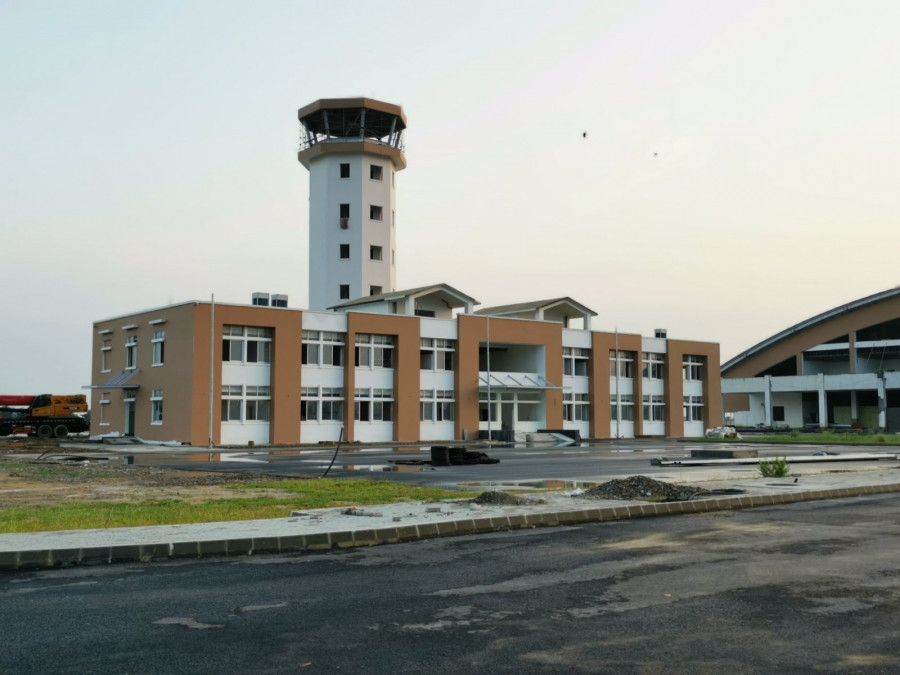National
Bhairahawa airport headed for list of longest running construction projects
Thai contractor reluctant to begin work fearing safety of workers as virus caseload in Nepal is on the rise, officials say.
Sangam Prasain
The Bhairahawa international airport project is set to earn a place among the list of longest running construction projects in the country as the much-delayed scheme has stalled once again due to Covid-19.
Construction started in 2013, and was expected to be completed in 2017. But the project encountered multiple hurdles which pushed back the completion deadline several times. The latest completion target was set for December. Since there's no way the airport will be finished by then, the date has now been postponed to mid-2021.
Despite more than 90 percent of the construction works having been completed, the project’s second package—installation of communication, navigation and surveillance, air traffic management and meteorological equipment—has been pushed into uncertainty.
“Despite our several attempts and pleas, the contractor for the second package is reluctant to begin work as the virus caseload in Nepal has been increasing,” Rajan Pokhrel, director general of the Civil Aviation Authority of Nepal, told the Post.
In March 2019, the state-owned Thai company Aeronautical Radio of Thailand (AEROTHAI) won the $4.83 million contract for the second package, which it had pledged to complete by the end of the year.
“We even decided to send a chartered plane to bring the workers and technicians to install the navigational, air traffic management and meteorological aids; but they are firm and don’t want to set foot in Nepal until the virus cases come down to zero,” said Pokhrel. “We can’t force them outright as the pandemic is still raging on.”
And as respiratory viral infections like Covid-19 are much more active in the winter, work on the second package may not begin before February, according to civil aviation officials.
Pokhrel said given the situation, the project completion deadline is almost uncertain.
Nepali officials say that the project may take at least five months to complete—three months for installation, and two months for testing and commissioning, and flight calibration of navigation and communication systems together with flight procedure design.
Located in south-central Nepal, Gautam Buddha International Airport will be the gateway to the international pilgrimage destination of Lumbini, the birthplace of Gautam Buddha. The airport will have a 3,000-metre-long and 45-metre-wide runway.
Officials familiar with the development said several rounds of discussions had taken place between the Thai company and the civil aviation body.
“The contractor is saying that even if it sends its technicians, there must be a guarantee that they are not infected by the virus,” said the official. “No one can guarantee such things.”
The Civil Aviation Authority of Nepal had awarded the first package—the Rs6.22 billion civil works component—to China’s Northwest Civil Aviation Airport Construction Group in November 2013.
According to officials, if the technicians fail to come by the end of this year or early January, it’s highly likely that Pokhara International Airport will come into operation before Gautam Buddha International Airport.
Pokhara airport has set a completion deadline of July 10, 2021.
Pokhrel said that they had been requesting the Thai Embassy in Kathmandu to facilitate the process of bringing technicians to Nepal as the Bhairahawa project may be severely delayed.
Even after the lockdown was lifted in the third week of July, projects funded by the government or private institutions were allowed to mobilise local workers, but foreign technicians were barred from entering the country, resulting in work coming to a halt at several projects that were close to completion.
Although the the government on August 21 decided to resume charter and regular flights from September 1 for Nepalis and representatives of diplomatic missions, the United Nations and development partners, it was only on September 14 that the Cabinet allowed projects to bring technicians from foreign countries since many of them had been in limbo with skilled workers stuck in different countries due to the lockdown measures imposed by Nepal to prevent the spread of the coronavirus.




 13.12°C Kathmandu
13.12°C Kathmandu

%20(1).jpg&w=200&height=120)













